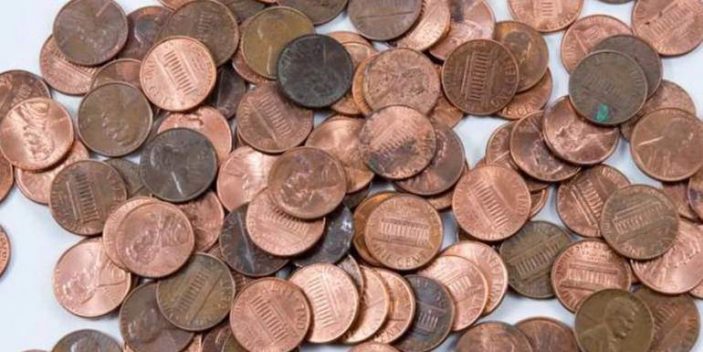Zinc has many functions in a cat’s body and a deficiency will result in some deficiency symptoms. However, a high serum level of this trace mineral is detrimental as it causes toxicity.
Once absorbed, it initially binds to 2-macroglobulin and plasma albumin before it is transported to the liver, kidney, muscles, and pancreas where it is deposited. Its excretion is limited, and it occurs via bile, mucosal cells (into stool) and pancreatic secretions.
As MSD Manual notes, “zinc salts have direct irritant and corrosive effects on tissue, interfere with the metabolism of other ions such as copper, calcium, and iron, and inhibit erythrocyte production and function.”

Causes
Normal dietary content and zinc supplementation in cats or even dogs are unlikely to cause intoxication. The most probable causes include:
- Swallowing of coins containing this element such as US pennies made as from 1982 or a £1 and £2 coin.
- Ingestion or licking of human, dog or cat sunscreens containing zinc oxide
- Ingestion of nuts, nails, zippers, jewelry, board game pieces, batteries, auto parts, some toys, bolts, and other galvanized materials and its alloys (brass and bronze) including those for making some cages.
- Human lozenges containing zinc
- Topical creams and ointment (including zinc oxide ointment) contain this mineral such as diaper rash, deodorants, and so on.
- Products with zinc sulfate, gluconate, acetate, sulfate, etc., as well as zinc-containing paints, fertilizers, antiseptics, suppositories, fungicides, and shampoos.
- In rare cases, too much supplementation of this mineral including in mineral and multivitamin supplements.
Symptoms of zinc toxicity
Once zinc-containing object has been ingested, it will quickly dissolve in the stomach being acidic forming zinc salts which will then be absorbed into the body when they reach the duodenum then small intestines.
The presence of an excessive amount of zinc both in the gastrointestinal system and body may result in several symptoms which include the following:
- Vomiting after about an hour
- Lethargy and depression
- Diarrhea and changes of feces color to orange
- Abdominal discomfort and pain
- Loss of appetite
- Higher heartbeat rate
- Anemia symptoms such as pale gums due to the destruction of red blood cells
- Urine color change due to high hemoglobin
- Gum jaundice
- Collapse
- Death
Besides destroying red blood cells, zinc poisoning in these pets can also lead to heart and kidney failure as well as liver damage.
Diagnosis
Due to serious risks of the poisoning that this mineral causes, contact your vet immediately you suspect your cat, dog or even bird has swallowed a zinc-containing metal for radiographs (x-rays).
Your vet will conduct a physical examination, inquire more about the history and progression of the various symptoms including their timelines. Some of the tests that may be conducted include:
- Complete blood count or hemogram – This test will reveal chances of hemolytic anemia due to the red blood cells (RBC) destruction as well as indicate granule or Heinz bodies formation inside red blood cells as well as a variation RBC coloration.
- Blood chemistry profile – It is intended to reveal high bilirubin and hemoglobin. Organ failure may be indicated by a nitrogen, liver and pancreatic enzymes varations as well as creatine in blood from normal values.
- Packed cell volume – determine RBC that has not been damaged or still working normally.
- Urinalysis – to check if there is still a normal kidney function
- Zinc blood level tests – indicate its level as well as toxicity by looking at how clotting occurs.
- Coagulation profile – helps detect how various organs have been affected.
- Also, there will be a check for the presence of “abnormal red blood cells with an unusual dark ring surrounding a dark center known as target cells; this is associated with anemia,” states PetMD.
Treatment and prognosis
Firstly, your vet will try stabilizing your cat using supportive therapies such as IV fluids to stop dehydration, ensure there is an electrolyte balance, and spur more urination and help to get rid of zinc. There will also be oxygen therapy is necessary as well as treating any shock symptoms.
Also, medications for reducing stomach acidity such as omeprazole may be prescribed since lower pH favors more zinc dissolution, the use of cat antiemetics to help stop excessive vomiting and the use of medications to minimize stomach corrosion (gastro protectants).
Once the patient is stable, and if the swallowed object was spotted during X-ray, your veterinarian will remove the swallowed object containing object such as a coin (by endoscopy, induced vomiting, or surgically). Surgical removal will require postoperative care.
In case your feline has become anemic, a blood transfusion will be considered followed by continued health monitoring and laboratory tests to see if its health is returning to normal.
Prognosis depends on how soon the poisoning is detected or when treatment begins. Cases, where organs have failed, may minimize survival chances and a poor prognosis.
Finally, recovery will be quick if there has not been much damage and the source of the poisoning has been eliminated.
Prevention
Ensure all Zn containing metals are secure, store coins and other galvanized objects or alloys safely, change locks on your cat cage if they are made of this element and correctly store any products such as lotions and topical medications that have it.
